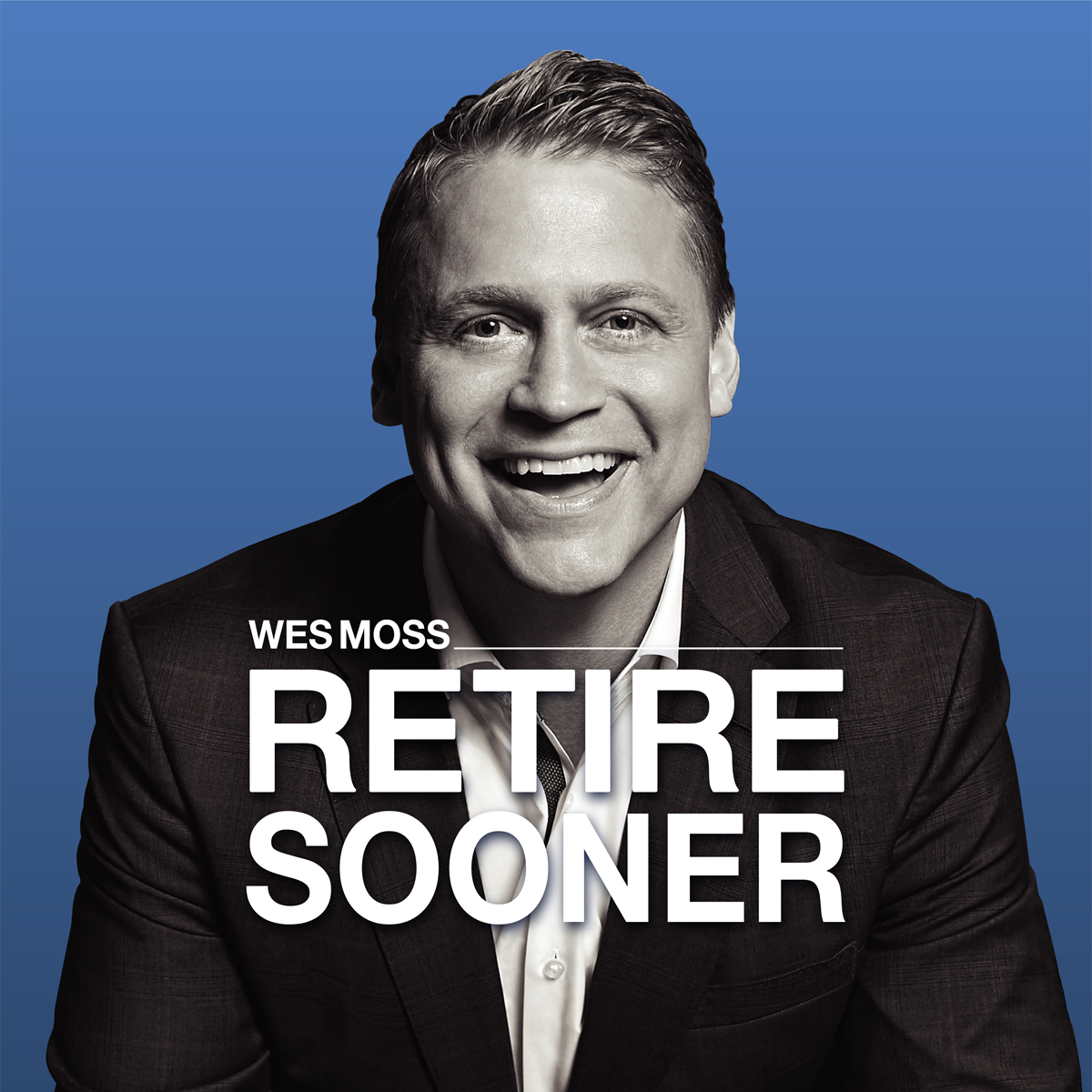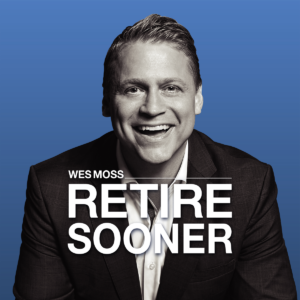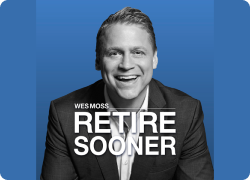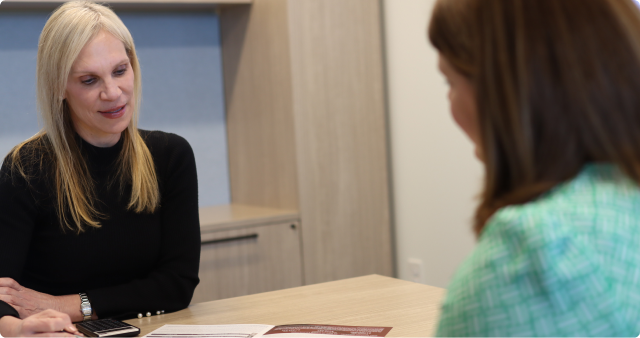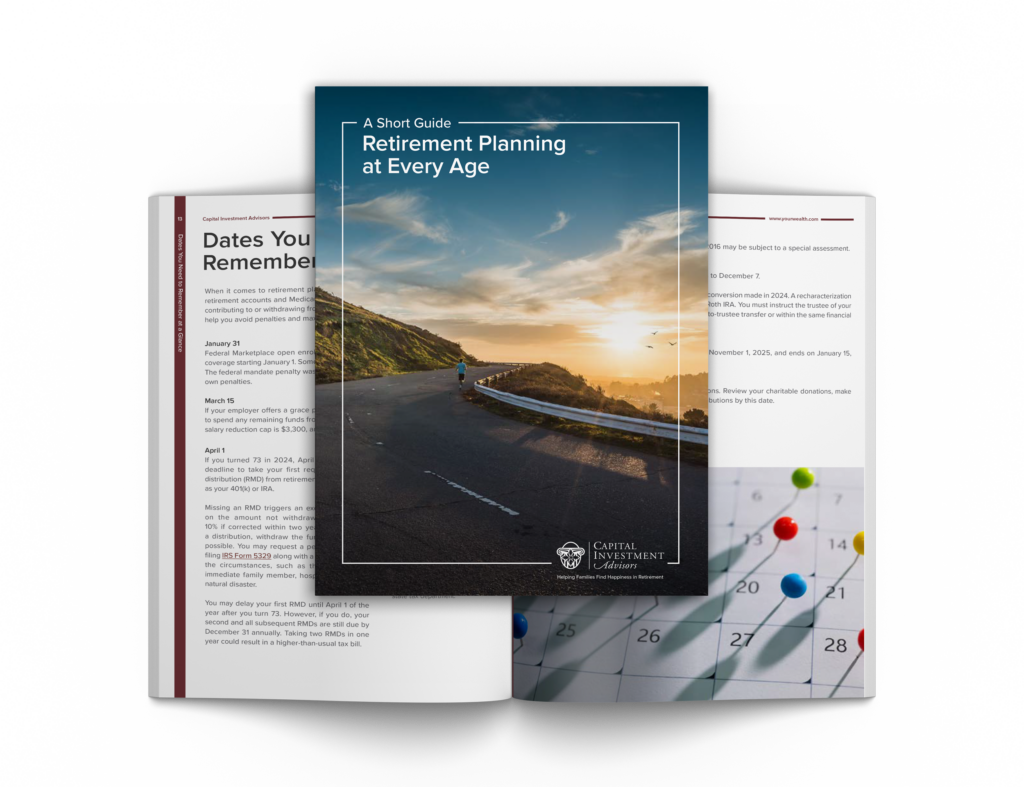Wes and Christa delve into essential topics to help get you ready to retire sooner and happier, including:
-
Review the Wes Moss 10-point retirement readiness checklist.
-
Understand how to transition from saving to spending. It sounds simple, but there can be more to it than meets the eye.
-
Explore the emotional and strategic importance of spending in retirement: What are productive ways to prioritize?
-
Reassess your estate, insurance, and healthcare coverage before retirement—procrastination can add unnecessary stress.
-
Be aware of advisor fees vs. value: you’re not paying to beat the market, but to build and protect a sustainable plan.
-
Embrace the importance of financial confidence: the #1 worry in retirement is outliving your money—face it with planning.
-
Enjoy a lighter segment of “Wes Stinks” regarding Wes’s favorite type of apple vs. listener favorites.
-
Follow real-life financial questions from listeners:
-
With a significant chunk of assets and kids still in college, analyze early retirement readiness and weigh the pros and cons of hiring a financial advisor versus staying with index funds.
-
How to shift from aggressive stocks to conservative holdings while attempting to minimize capital gains tax.
-
Dissect a high withdrawal rate strategy using dividends and bond funds. Consider the trade-offs of control and structured income.
-
Evaluate municipal bond funds for tax efficiency; can you balance credit quality and yields using a tax-equivalent yield comparison?
-
Weigh traditional vs. Roth 401(k) contributions based on your current tax bracket.
-
🎧 Tune in now to hear stories, stats, and effective financial planning that could reshape your future. Subscribe, share it with a friend, and take one step closer to your happy retirement. Follow the Retire Sooner Team on Instagram and YouTube.
Call 800-805-6301 to leave a voicemail or contact us HERE for a chance to have your question featured in an upcoming episode.
Read The Full Transcript From This Episode
(click below to expand and read the full interview)
- Wes Moss [00:00:04]:
I’m Wes Moss. The prevailing thought in America is that you’ll never have enough money and it’s almost impossible to retire early. Actually, I think the opposite is true. For more than 20 years, I’ve been researching, studying and advising American families, including those who started late, on how to retire sooner and happier. Now I’m bringing in my good friend Christa Dibias, who has worked closely with Clark Howard for many years now to answer your questions and explore what makes a happy and fulfilling retirement. My mission on the Retire Sooner podcast is to help a million people retire earlier while enjoying the adventure along the way. I’d love for you to be one of them. Let’s get started.Christa DiBiase [00:00:51]:
We’re talking about investing, retirement, all sorts of great stuff. Today we’re going to get to your questions.Wes Moss [00:00:57]:
I’ve been noticing a lot of the questions are Wes and Christa.Christa DiBiase [00:00:59]:
That’s very cool. Do that today you’re going to have a couple of really interesting topics. One is something people ask a lot like when am I ready to retire? When am I going to be ready to retire? And you actually have like a checklist.Wes Moss [00:01:11]:
A 10 point checklist.Christa DiBiase [00:01:13]:
Yeah. So that’s, that’s pretty awesome. And then you’re also going to talk about transitioning from saving to retirement and what the spending in retirement really looks like.Wes Moss [00:01:23]:
Yeah. How do you start taking what you’ve been saving forever? How do you start withdrawing it? It sounds simple, but there’s a lot to it.Christa DiBiase [00:01:31]:
Awesome. Okay, well, let’s get to it.Wes Moss [00:01:33]:
So we’ll start with a checklist. And if you’re thinking about retirement, it’s almost a little overwhelming of like there’s infinite things to think about and do. And I think it’s important to consolidate that down so you’re not, your head’s not spinning around such a big situation. I’m going to stop working. When do I start withdrawing cash? Do I’ve got to worry about my home kids? There’s just so many things to worry about. So we’ll just, let’s consolidate that down into 10 things so we can kind of stop the chaos of all the different questions circling around that. And so here we go. So the first one be counted up.Wes Moss [00:02:11]:
Second one is map it out. Third is paint a picture of your retirement life. Four is lock in your income streams. I’ll start with those quickly. The first one is when I say count it up, you need to do an inventory of all of your different assets. That is the first step. And that is it’s. Some people don’t love to look at every different account.Wes Moss [00:02:32]:
There’s a little bit of a, there’s some comfort with head in the sand, but that doesn’t really work when it comes to planning out the next 20, 30 years of your life. So it’s really you. And if you have a partner sitting down and counting it up and saying, oh yeah, we have this account over here and oh honey, don’t you have this old 401k over here? So you get an inventory of that and then with that same inventory would be your real estate, not just your investment accounts, but your real estate and any sort of debt. So that is the first step we’ve got to do. We’ve got to be honest with ourselves about what we have and what we don’t have and then our liabilities. Second would be the thought around mapping out a retirement game plan. And this is one that I think just will calm everyone’s fears down. And I’ve done a lot of research lately.Wes Moss [00:03:19]:
I’m always studying happy versus unhappy retirees. One of the things I see in retirement planning is that it’s pretty easy to do a retirement plan and when you get to that stage where you’re within a year, it’s better to do it 10 years prior or even 20 years prior. But getting to retirement, it’s pretty doable to do a plan. And there’s great comfort for folks when you’re getting into retirement to just get it done. And it doesn’t have to be so the industry will provide, whether it’s a website or an online planning calculator or you sitting down with an advisor, a fiduciary that can help you map it out. The plans really work because they take in all the main variables that you need to understand. And then you’re spending. So you’ve got a part of that inventory is hey, what are we going to spend? And that can be just a round number.Wes Moss [00:04:10]:
It doesn’t have to be exact. It needs to be directionally right. And then the plan itself accounts for an assumed rate of growth and assume rate of inflation and puts all of those into a really comfortably clear way to figure out. And I think that reduces a bunch of anxiety. So I think mapping it out is number two. And again, that can be pretty comprehensive. Your withdrawal strategy, your taxes, but that’s all in number two. Number three.Wes Moss [00:04:39]:
This is less about the numbers and more about painting a picture of your retirement life. I did this exercise with my, my dad and my stepmom maybe a year ago or maybe let’s call It a couple years ago, and I was just visiting Pennsylvania, and on the refrigerator was her retirement roadmap, which I had them do in colored pencils.Christa DiBiase [00:05:01]:
Oh, very nice.Wes Moss [00:05:02]:
And it’s a really fun exercise, is to sit down and think of the things that you want to do, all the fun things that you’re looking forward to doing, all of your core pursuits, all of your socialization, family, friends, hobbies, core pursuits, I call them. And I almost like to do a map of the United States or the world. And you can point to where you want to go, travel, and it’s a really fun way to clarify all the fun things you want to do. I call it just a retirement roadmap, but if you do it in colored pencils, it may end up on the refrigerator wall. That was pretty cool to say. This is my stepmom’s. I don’t know if my dad put his on the fridge. Number four, lock in your income streams.Wes Moss [00:05:44]:
Meaning that income streams. And again, part of this may be in the planning, but they may not all be turned on. Right. So you can have Social Security be turned on at any given point in the future up to the age 70, and you’ve got to make that decision. What about a pension from somewhere else? Maybe you have some sort of annuity that kicks in or a potential inheritance. I see this a lot, folks that don’t have annuities, but their parents maybe had annuities and now they’ve inherited that income stream. So spend some time understanding those income streams. They’re so important in retirement.Wes Moss [00:06:19]:
They are. They’re like kind of the lifeblood of spending without you tapping your investment account. So that’s number four to me, is lock in your income streams. Number five is something you can totally control. I’ve seen this spin out of control. Number five is finish big projects, particularly with housing. And this is super clear. When you see somebody who retires, I’ve seen this.Wes Moss [00:06:43]:
They retire and they say, well, we’ve got to have a little bit more time. So we’re going to renovate the bathroom.Christa DiBiase [00:06:48]:
Oh, man.Wes Moss [00:06:49]:
Or we’re going to renovate the kitchen and it’s not a big project, or we’re just going to do the floors, and then it spins out of control. So it doesn’t. It’s not just a budget thing, which that’s a whole other story that can get out of control. But it’s a project problem too. It’s. Well, it’s the floors and it’s the kitchen, the bathrooms. The next thing you know, you plan on spending 50,000 doll and it’s 250. Wow.Wes Moss [00:07:12]:
And you’ve stopped working. So you don’t have time to cushion that and say well wow, we really overspent here and maybe I’m going to work another year to kind of pay for that. So get the big things done before you know you’re going to stop working. So the one to two to three years prior to your retirement get those big housing projects done. Number six is craft a plan to kill the mortgage. It is well documented in our research that retirement levels of happiness go up when your mortgage is either paid off or payoff is within sight. Again, not everybody is fortunate enough to pay off the mortgage before you retire but have a plan to pay it off in those early years of retirement. Number seven, get your health care ducks in a row.Wes Moss [00:08:02]:
There’s a huge jump when you go from having your own private insurance prior to age 65 to getting on a Medicare. When you get onto Medicare you’re going to need to get some sort of supplemental program. And when, when you get your Medicare supplement program, you’ve got to figure out what doctors stay what doctors are not in this plan. That will take typically meeting with someone that specializes within that space now you can research it and pick it on your own. So but I think it’s super important to get with someone whether it’s a referral from your advisor or a. But find a healthcare advisor and make sure that you’ve got the right supplemental plan for your state.Christa DiBiase [00:08:39]:
So I’m just curious about that real quick. A healthcare advisor are they do you really careful that it’s somebody who’s really not trying to sell you on one specific plan.Wes Moss [00:08:48]:
You know what I see in that industry and again this is just in the southeast is that healthcare advisors don’t they get. It’s such a small. Nobody’s making a big fortune. This is. They’re not selling annuities. There’s no giant commission when it comes to this. Do the healthcare advisors get some money to do this? Yes. They don’t do it for free but.Christa DiBiase [00:09:09]:
They’Re kind of like you want someone who’s more of a broker who’s gonna. Who’s gonna look at many different companies. So you don’t want some repping company.Wes Moss [00:09:16]:
Options, supplemental options in your state. And again I think it’s a, it’s a hard industry to be in. It’s not like these people are making huge amount of money helping. I think it’s not free but I think it’s an important service Number eight, tune up your estate plan again before you retire. It’s really important to make sure that even if you have wills, are they up to date? Maybe you did a will and your kids are young and now they’re grownups. Things change. Beneficiaries change, the amount of assets you have change. So you’re going to want to check this off the list of sitting down and making sure your will planning and your trust planning is in line with what you want.Wes Moss [00:09:57]:
If something happens to you and your spouse again, it’s one of these things that will swirl around in your head and giving investment and I’d say financial anxiety until you get it done. And that’ll take an estate planning lawyer as well to do that. Number nine, rethink your insurance. You don’t want to go into retirement without being properly insured. And that again, it’s a different phase of life when you’re in your 30s and you’re trying to protect your kids with life insurance. Maybe you don’t need to do that anymore. Make sure your property and casualty insurance is up to date. Make sure you have some sort of umbrella policy when you’re heading into retirement.Wes Moss [00:10:36]:
The last thing you want to do is have some sort of weird liability for somebody that gets hurt at your house. So this is about protection. Insurance really is about protection. And it’s something you need to check off the list. And then number 10 on my list to check off is the digital side. So do a digital. I don’t know if it’s digital detox or a digital kind of. Do a digital review and make sure that your investment accounts all have dual authentication.Wes Moss [00:11:06]:
Make sure that your bank accounts have dual authentication. Make sure there’s a area where your passwords are set somewhere safe. And whether it’s in an app or someplace in the house that if something happens to you or your spouse, you can make sure that you can still.Christa DiBiase [00:11:21]:
Get into your bank accounts or somebody else can.Wes Moss [00:11:24]:
Or somebody else can. So getting some digital security and some, again, a lot of these are just getting our head out of the sand, facing up that we need to get them done. You go through that 10 point checklist, you’re going to have a lot less anxiety when it comes to pulling the retirement trigger.Christa DiBiase [00:11:40]:
Great. All right, I’m going to ask you a couple questions and then everyone who listens to Clark, we have a West Stinks. A fun West Stinks. I’m going to read.Wes Moss [00:11:49]:
You already have a West Stinks.Christa DiBiase [00:11:50]:
Yes. This one’s from Brian in Colorado. Some background on us. My Wife and I are both 53 have been aggressive savers over the years. Our home, cars and credit cards are paid off. We have no debt. When is it safe to call it quits and enjoy some of what we have worked so hard to save? We have three kids and hope to fund the cost of their undergraduate education. One child’s finishing his sophomore year in college, so we have 4 plus 4 plus 2 equals 10 years of tuition remaining to cover.Christa DiBiase [00:12:19]:
With the status of the economy and the potential of ageism, should we lose our jobs, I daydream about the possibility of an early retirement. Here are their savings. Retirement savings, mostly traditional. Some Roth IRAs, 401 s and HSA 2.7 million taxable investment accounts. A mix of index funds and dividend producing large cap stocks. 1.4 million cash CDs, money markets 1.1 million. We are slowly feeding this into the market. Maybe 50,000 a year, but it never seems like the right time for a big purchase.Christa DiBiase [00:12:51]:
529Savings, 400k as a follow up question, when does it make sense to have a professional manage our accounts? I hate to pay someone 50k per year 1% of 5 million only to be disappointed when they can’t outperform an S&P 500 index fund.Wes Moss [00:13:06]:
Hmm. Okay. It seems like educated Brian in Colorado, I think it seems like education is paid for for the most part. I mean 10 years is a lot to pay for still. But. But $400,000 already in a 529 plan, that should cover most of it unless they’re all going to expensive private schools. And it sounds like, and that’s a really good point here is that maybe I should put it on the retirement checklist. It should say get your kids through college first.Wes Moss [00:13:34]:
Now most folks are already done with that. But when you’re a really early retiree, you maybe have a crossover with kids in school. I would say that is a really. It’s something that it should be on. If I did an early retiree checklist, this would be on it. Meaning the kids school needs to be done because it’s a little bit like a housing project. You never know how much the year or multiple years will cost. And maybe the kids go an extra year and they say I still need more money for school.Wes Moss [00:14:05]:
So you want to get them done and independent before you’re going to the daydream, which I love to hear about. This comes to reality. So that’s one. I check that off the list. It sounds like it’s mostly ready to be paid for. Number two. I mean, the assets add up to. I mean 271411.Wes Moss [00:14:24]:
They add up to a little over 5 million. 4% rule means that you could spend $200,000, you could spend 200 grand right out of the gate forever and then increase that by inflation. Let me make sure I’m doing my math right here. So 5 million times, let’s call it.Christa DiBiase [00:14:44]:
And you’re talking about my iPhone.Wes Moss [00:14:45]:
Wanted to do an update while we’re.Christa DiBiase [00:14:46]:
That’s okay.Wes Moss [00:14:47]:
While we’re sitting here doing the show, I said we can do the, we can do the iPhone update later.Christa DiBiase [00:14:51]:
When you say the amount you can pull out, you mean gross, right?Wes Moss [00:14:55]:
Right. So 4% of 5.1 is $204,000 a year. That’s the gross amount that you could be withdrawing from your investment account. If you’re an early retiree, the income streams aren’t going to kick in yet. So you really, you’re not going to be getting Social Security if you retire in your mid to late 50s. If you have a pension, that probably won’t be kicking in. So it really is withdraw from the portfolio. But if that still covers the bills, the net amount after that 200, I think you’re in completely fine shape.Wes Moss [00:15:24]:
So I think that retirement is absolutely possible. There’s two other quick questions. One, I’ll just address the financial advisor part of this. First of all, when you have that much in assets 5 million level, you’re usually not paying 1%, meaning that you’re usually in the.09, 0.8, 0.7. Again, this totally depends on who you’re working with. But still significant 0.7 on 500 million is 35,000 a year. Absolutely. You’re not paying an advice we.Wes Moss [00:15:53]:
You’re not paying a financial advisor ever to beat the s and P500. That is not a thing. And I say that because if you want to beat the s and P500 or any index, that’s when you’re either doing this on your own or you’re looking at a hedge fund or a mutual fund. You’re looking at an asset manager. And still most of the time that doesn’t necessarily happen either unless you’re taking a whole lot of risk. You’re paying an advisor to make sure that all of those things you would like to go right over time, in fact go as planned. And there’s a lot to that. It’s not just about beating the market.Wes Moss [00:16:35]:
And if you’re worried about that, then you should probably just be a pure index fund investor and Just get the market return and deal with the volatility that comes along with that. And that’s not necessarily a bad plan either. But an advisor is going to make sure all those different areas like estate planning, asset protection, withdrawal strategy, allocation that you can live with in retirement. Because when you get into retirement, investing gets scarier. Just it’s just the reality. Again, more recent research I’ve looked at number one worry even above health. Christa. Now it’s almost tied but statistically it’s a lot.Wes Moss [00:17:09]:
The number one concern in retirement is your finances and dealing with an uncontrollable situation like the economy going bad. Advisor’s there to get you through that and that’s whatever that should be a manageable to small percentage can really pay dividends over time. Otherwise you can just find a fund or two or a hedge fund that is trying to in fact beat the market. That’s in my opinion usually not a great strategy. And then lastly, I think he asked about dollar cost averaging in it is a lot to put a million plus dollars to work. We’re in an interesting interest rate environment where rates are not low at this point. So that’s good for bond investors today in this kind of environment we’re in, but investing a tiny bit of that to take a couple of years. I think if you’re going to get invested in a balanced plan, you want to do a six to nine month weighed in strategy as opposed to a multi year way to do it.Christa DiBiase [00:18:09]:
Okay. David in Massachusetts says years ago a financial pundit on TV talked about the power of compounding savings for retirement. The time I only had a checking and savings account. So I opened a self directed brokerage and started putting $1,000 a month into it. I subscribed to a newsletter that followed a Buffett style approach. Buy solid companies, hold long term, avoid day trading. I’d invest in their monthly picks and only sell when they said to. 20 years later I’ve built over $2 million.Christa DiBiase [00:18:35]:
With the stock market feeling turbulent, I’ve been thinking about the future, specifically retirement. I’m considering moving some money from aggressive stocks into something more stable. So in about five years when I retire, I won’t be exposed to extreme swings. But I’m worried I’ll be hit hard by capital gains taxes when I sell. Is there a smart way to shift from aggressive to conservative without a big tax hit? Would it make sense to sell from my regular brokerage and reinvest in a Roth? Since Roths are taxed up front, Would I be taxed twice? Once when selling again. When funding the Roth, should I just leave it alone or sell what I need later? I’ve heard selling in a down market near retirement can hurt with no time to recoup losses. But won’t leaving it in tempt fate?Wes Moss [00:19:17]:
Yeah, Look David, this goes back to our last question. You may be an aggressive investor from 30 to 60, but when you get in retirement, you’re worried about big swings in your retirement accounts. So you want to have some sort of balance there. There’s two ways to look at this. One, we pull out our gain loss tab. Now if you’ve been investing and been buy and hold mostly for 20 years, you may not have any losses, maybe no losses at that point, but you certainly have, you’ll have a few big winners. That’s the way the market works. That’s just the way that when you’re diversified and you’re investing, you’re going to have a couple winners that really kind of carry the day and you’re going to have some that have been a little more lackluster.Wes Moss [00:20:01]:
So you would start with anything that’s even flat to down, you may not have that. You would potentially reduce your lower winners is one way to start doing that. And you do that slowly over time. So you’re keeping your capital gains at a level where you may pay zero taxes, right? Certain income brackets, long term capital gains are taxed at zero. So that’s one strategy to start chipping away. And then what you’re able to sell, even if it’s at a gain, if you’re in the right tax bracket, it could be no to minimal long term capital gains. And then you reinvest that in more safety assets. That’s the way to do it.Wes Moss [00:20:36]:
The other way to think about this would be almost reverse dollar cost averaging, meaning that you do a schedule over time that so this avoids really high peaks in the market and troughs in the market. You make a plan to say, look, I really want 20 or 30% of this to go to more conservative assets. So do a little bit every month, but you’re selling here. So this is like reverse dollar cost averaging. Sell 1 or 2% in any given month and that will help ride out the market swings and give you the capital to reinvest in some of these more safety oriented areas. Now the Roth idea, it’s almost really Roth is about this wouldn’t be a Roth conversion because it’s not coming from an IRA and putting it into a Roth. So that’s not, we’re not talking about Convergence here you’re really just talking about Roth contributions. And you can only do up to.Wes Moss [00:21:33]:
If you’re 50 plus, it’s only $8,000 in any given year. And that would just go back to if you have earned income. If you’ve earned income of that much or more, you can make the contribution. But you’re not going to want to say that the money from my brokerage is then going to go into a Roth that’s more of a IRA to Roth conversion. But not in this situation.Christa DiBiase [00:21:54]:
Okay, now the west stinks, which are. These are just fun. On a recent ask, yes, I’ve seen some Clarks.Wes Moss [00:22:01]:
Some of them are kind of brutal.Christa DiBiase [00:22:02]:
Well, he doesn’t think so. He loves it. Wes called himself an apple connoisseur after.Wes Moss [00:22:07]:
Seeing this about apples.Christa DiBiase [00:22:09]:
Chris Pink apple is the best apple. He must not have tried the Sweet Tango, pronounced Sweet Tango apple. Available from mid fall to early winter, it’s the best apple on the planet. According to applerankings.com my own taste and my own taste buds. The Sweet Tango apple is the holy grail of apples. Perfect in almost any way, scoring a 97 out of 100. The Crips Pink Apple scores a 42 out of 100 and is likened to horse food according to Apple rankings. And that’s from Mike in Denver.Christa DiBiase [00:22:39]:
And also, kids, Kevin wrote in to say you were incorrect with your apple choice. The snapdragons from Aldi are the best.Wes Moss [00:22:46]:
Oh, you know, I don’t. Kevin is not totally wrong. Kevin is not totally wrong. There is a snapdragon apple and I get these at Whole Foods and they’re in a mat. Boy. No, no, no, no. I’m sorry. Fresh market.Wes Moss [00:23:00]:
Fresh market is where it’s still. They’re expensive.Christa DiBiase [00:23:03]:
Clark. Somewhere screaming right now, Aldi. Aldi.Wes Moss [00:23:06]:
But there is nothing like the snapdragon apple because they’re small. They’re almost like the apples we would pick off in the hometown orchard that you would feed to a horse. Like a horse would eat one of these in one bite. They’re little. They’re like for lunch boxes, but they’re super snappy. They have a great name, Snapdragon. And they’re juicy snappy. They last a long time.Wes Moss [00:23:29]:
And the snapdragon is really good. I’d rank it just under the crisp pink. Now, the Sweet Tango is. First of all, there’s no way that I don’t know what ridiculous website you’re going to that would call a crisp pink a 42 out of 100 and be like a horse food. This is the one apple you don’t feed to a horse because it’s so great. Horses don’t get the nuances between all these different apples. They’re fine with an old Granny Smith. You don’t need to feed them a pink Crisp or a Sweet Tango.Wes Moss [00:24:03]:
I’m not saying the Sweet Tango is bad. It’s a pretty good apple. The problem I have with it, I like the russeting. Like it has some russeting which are like that little quirky thing. It’s like the little barky thing that gets raised on the skin apple kind of makes it a little more rustic.Christa DiBiase [00:24:20]:
I had no idea.Wes Moss [00:24:22]:
There’s no russeting on the pink complexity to apples. You dig into a Sweet Tango and it can be a little yellowy and a little ivory oriented and I don’t like that. And they don’t. They don’t sit and last as well. But you may like them and this is a preference thing. So I’m not going to disagree that the Sweet Tango is good. I’m just saying that the, the crisp pink, a good one, is the best apple. It’s.Wes Moss [00:24:46]:
It’s a 99 on my scale out of 100. And it still beats the Sweet Tango. I would just. You’re at the. You’re on the wrong website. Anybody that calls Pink Chris horse food is just that. That’s. Just.Wes Moss [00:24:58]:
That’s. I think that is. I think that’s heretical.Christa DiBiase [00:25:03]:
Okay.Wes Moss [00:25:03]:
That’s. I mean, that is. That is blasphemy. Wow. What I’m looking for that would be. Would be Apple blasphemy.Christa DiBiase [00:25:11]:
Apple blasphemy. Well, if you’re still with us, we’re going to get back to it coming up straight ahead and we’re going to talk about structuring what you spend in retirement.Wes Moss [00:25:22]:
Are you facing a fork in the road and deciding between continuing your career and retirement? I’m Wes Moss and this massive life decision shouldn’t be taken lightly. Talk with my team. If you’d like help reviewing your retirement accounts and building a financial plan, we can help you review options and offer an opinion based on your best interests. You can find us@yourwealth.com that’s y o u r wealth.com. what are we talking about right now?Christa DiBiase [00:25:53]:
Aren’t you talking about how to spend in retirement?Wes Moss [00:25:55]:
Spending in retirement. This came up and here’s why. One, I think you guys wanted me to talk about it. And two, I was doing a radio show a week ago and one of the producers who’s on. On the air is in his early 30s. And he said, he goes, wesley, when you get to retirement, how do you actually take the money? Is it able to be do I take it right from a 401k or do I have to put the money in another account in order to spend it? Because if you hadn’t really thought about this, it is a question. It’s not like your retirement accounts are not checking accounts. You don’t just write checks out of them.Wes Moss [00:26:34]:
So where does it go? How does it work? So that’s the first question. The second question is it’s not as simple as I’m going to pull money out and just pay the tax and go. There’s a lot of strategy behind this and it’s incredibly important of how you use the three main buckets. And the buckets are individual or brokerage account, which could be savings account or taxable account. I call them an after tax account. Number two, is your any retirement account, 403, 401k, 457, 401k, obviously, and an IRA or individual retirement account. And then the third bucket is a Roth. And how you use those three really matters in managing your overall tax bracket.Wes Moss [00:27:15]:
And the key, what we want to do is be able to keep and manage our tax bracket most efficiently for as long as we can when we get into retirement. And it all matters on which one of these buckets you tap first. So number one, we’ve got to get to the right age. Really, for most retirement plans, it’s 59 and a half. That’s the age when you can tap an IRA without paying a 10% penalty. Now there’s the rule of 55, which is if you retire from a job and you leave money in your 401k, you could start tapping without penalty at 55 plus. But for the most part, first of all, know the age you’re able to tap these accounts. Again, mostly it’s 59 and a half.Wes Moss [00:27:54]:
For some folks it could be 55. Secondly, we need to recognize the three buckets. Third, let’s start with a simple example. If you only have retirement accounts and you’ve been an amazing saver and you’ve got a million dollars saved in a 401k plus an IRA and you have $50,000 in an after tax savings account, you still have plenty of money, but you really don’t have many decisions to make. It’s just, it’s got to pretty much you don’t want to spend your, what I call it the most sacred bucket, which would be an after tax account or a Roth. But that money you can typically pull out in a very tax efficient way. Roth, of course it’s going to be tax free as long as you’ve let it bake as long as it needs to. A savings account that’s just in cash.Wes Moss [00:28:39]:
Again, you’re typically not going to have any sort of capital gains to use that A brokerage account, this is where you can manage how you pull money out. But if you’re only most 95% of your assets are retirement money, it just is what it is. In that case you want to judiciously pull money out. So you only want to pull out just what you need to cover your expenses. Otherwise you’re increasing your overall adjusted gross income and as that goes up, your tax bracket goes up. So you want to do it in a really measured way if that’s your only option. But most people are going to have a series of different accounts to decide on which to pull from when. And the general order I would say the way to think about this is after tax are individual brokerage money first, then IRA money goes next and then you save the Roth for the bigger chunk expenses you would need in retirement.Wes Moss [00:29:32]:
New roof, 20 grand. I don’t want to take it out of the IRA because I’m going to have to pay taxes on that money in order to get to it. The Roth should be tax free. So I like to use the Roth as kind of a big expense chunk buffer in retirement. But that would be the order logistically. And this goes Back to the 33 year old’s question like well, how does it really work when you pull money from an ira, it’s typically going to go if you’re going to spend it, it’s typically they go to your checking account where you actually spend money from. But to get it there, there’s a process which you’ve got to fill out IRA distribution forms and you’re going to have to elect your tax withholding. So there’s a federal number and there’s a state number.Wes Moss [00:30:15]:
Now you don’t have to withhold taxes on IRA withdrawals, but most people like to keep their if you know you’re in the 20% tax bracket and you’re pulling money from an IRA, people will typically like to just withhold the 20%. That 20% sliver actually goes to the IRS and then you get the net actually. And then let’s say you’re withholding. Now if you’re in Florida, you’re not withholding for state, but if you’re in a state with income, state income tax, let’s call it 5%, then you’re typically withholding 5% that goes to the state. So when it comes to what you receive in your bank account from a retirement plan distribution, it’s typically net of the federal and the state withholding that you get to choose if you’re only in the 10. If you’re in the 10% bracket, you would typically elect to be 10. If you don’t do that, then at the end of the year everything you pulled out is fully will be towards your AGI and you’re going to have to pay taxes on it anyway. Now, if I look at two different scenarios.Wes Moss [00:31:15]:
Let’s say Sandy is from Oklahoma and she has $300,000 in an Iraq, 300,000 in brokerage and 150K in Roth. She got 950 grand, or I’m sorry, 750,000, Sandy could say. And she, let’s say she gets 30 in Social Security and she needs 70 to live, or she gets 40 and Social and 70 live. So she needs to take out $30,000 a year. She could elect to just take it all day one from the retirement account and now her income is going to be the Social Security, any, all of the dividends and interest that she’s getting already in the, in the regular after tax account because that’s a, I’d say a current pay by the day account. Anything that happens in a brokerage account, any transaction, a dividend interest, the sale, a capital gain or capital loss that’s owed, the taxes on those transactions are owed in that given year. So by not electing to use any of that money, she’s still having to pay some tax there and she’s paying tax on the whole $30,000 that she pulled out of the IRA. So that’s kind of a tax bomb situation where you’re paying as much as you really would need to pay.Wes Moss [00:32:27]:
Conversely, Sandy could say, well, I’ve got this $300,000 in brokerage, $100,000 of the three is in fixed income or bonds and it’s mostly just paid me interest and it hasn’t really appreciated. So she could elect to use that part. And she’s really just returning her own principal, so there may not be any capital gain there at that point. So she can pull money from that account with no capital gains potentially and not increase her income and not take anything from the ira. So she keeps her overall adjusted gross income really low, which keeps her other tax rates low when it comes to the Interest that she has to pay and the dividend tax rates are also income based. So it makes the whole process more efficient. Two scenarios, one not strategically thought out and higher tax, one strategically taking from the areas to keep and manage your tax bracket as low as possible. And that creates a big net difference to Sandy.Wes Moss [00:33:27]:
So that’s the way I’d look at it. Generally individual account first, then IRA or 401k, then Roth for special occasions.Christa DiBiase [00:33:36]:
Roth last. Well, not necessarily, but like you said, that makes sense. That’s interesting. I never would have thought of all that. All right, we’ll go to questions. We’ve got this one from Joe in Florida. We are 71, have about 500,000 saved in an IRA and traditional investment accounts. We have sufficient income from guaranteed sources to cover expenses and have about six months additional in a high yield savings account.Christa DiBiase [00:33:57]:
We look to our investments for additional income for play money and are unconcerned about leaving money behind with that.Wes Moss [00:34:04]:
That’s an important equation. Right.Christa DiBiase [00:34:06]:
We choose to invest in dividend stocks and ETFs plus different high yield bond funds. We withdraw 75% of earnings monthly with 20% of that sent to the IRS and the remaining 25% reinvested. With this strategy we are easily able to Average an extra $2,500 per month Net of tax withholding. We’ve had a financial advisor tell us that we are being very foolish that we would do better going into with an immediate annuity plus direct investment in the S and P and nasdaq. He claims our strategy is unsustainable even though it has worked just fine for a number of years now. What are your thoughts on this strategy for someone in our age group and situation? Never heard of one like this before.Wes Moss [00:34:47]:
Yeah, unsustainable. The advisor saying there’s something wrong with us. So let’s just think of Joe. The math here is important and on the surface it sounds like this has been working. So he’s been pulling this money out and his accounts still haven’t gone down. So it’s been working. So what’s the problem, advisor? Well, let’s do the math. 2,500 times 12 is 30,000.Wes Moss [00:35:13]:
$30,000 divided by 500 is what, Christa? I don’t know, 6%. It’s a 6% withdrawal rate. That’s a little high. But those are the wrong numbers. Those are the wrong numbers to use because what’s happening here, and this is, I think what your advisor’s looking at is that $2,500 is the net amount he’s getting, but he’s withholding 20%. So really what you’ve got to look at is 2,500 divided by adjust for taxes. It’s really about 3,125amonth times 12 is 37,500 divided by 500, Joe, it’s 7.5%. That’s why your advisor is saying.Wes Moss [00:36:03]:
That’s why he’s saying, I would think, I don’t know this guy, but I think what he’s probably saying is 7.5% is almost double the 4% withdrawal rate. It’s the quote safe rate. And even though you’re only receiving $2,500, it really is the gross number that’s going out. It’s that plus the taxes that are.Christa DiBiase [00:36:26]:
Getting paid, then they’re reinvesting the 25% remaining. Does that make a difference?Wes Moss [00:36:32]:
That shouldn’t make a difference because he’s actually not pulling from the account. So it’s really just what is depleting the account. Now here’s the other, here’s the other thought. If you go through a stretch of markets, it’s pretty good, right?Christa DiBiase [00:36:43]:
Which it has been.Wes Moss [00:36:44]:
It could easily, that could easily work. You could have, you could pull seven and a half percent out and you still have more because you’re making eight or nine. The four percent withdrawal rule is based on a long market cycle where you know that you will inevitably go through lower periods of rate of return. So it’s trying to protect you when things don’t go well in markets. The other thought is that you have again, I don’t know the dividend stocks here, but again, it’s hard to argue with dividend stocks. I’m a big believer in that. But also if you have high yield bonds or closed end funds and they’re a really big part of the overall allocation, they may pay out 8 or 9%. The problem with that typically is that there is usually a principal loss because sometimes those distributions are reducing the value of the fund.Wes Moss [00:37:33]:
If you have a $10 fund and it pays you a dollar, it’s a 10% yield. Hey, sounds great. But it’s really not great. If at the end of the year the Fund is at $9, it’s essentially just, it’s giving you your own money back. And that also could be happening here. I think that that’s probably the disconnect here, Joe. So what would we do? What would you do here? If you do it in Mediate Annuity, you’re going to get a higher rate here than what Your dividends will pay, but you lose the control of your money. You’re essentially saying, look, here’s my money.Wes Moss [00:38:08]:
Pay me forever until I die and or my spouse. So it might give you a higher overall sustainable income. But there’s really, it’s not so much that there’s nothing left at the end, because that sounds like that’s fine in your situation, Joe, but you do lose the control of being able to get to the money to go pay for a new roof if you need it. So I like keeping the liquidity and maybe just adjusting. You did say it was play money, so it doesn’t seem like you have to pull out that much. So maybe you just reduce your withdrawal rate a little bit and get it closer to that 4, 4.5% range. Well, compromise here I think makes everybody happy.Christa DiBiase [00:38:45]:
All right, Akshay in North Carolina says, would you please talk about tax exempt bond funds such as vteax, vw, ahx, or bond ETFs such as vteb? When should I invest in tax exempt instruments like these? How can one include these types of funds in their investment strategy? And are there any risks we should be aware of?Wes Moss [00:39:05]:
There’s always risks, Ashkay. There’s always risks. The you’re looking at tax free bonds in general, you’re going to, you’re talking about municipal bonds. These are obligations not to the US Government, but to a local government or a state. So they’re pretty darn high credit. Now you look at some states that have bad credit or underwater, and those municipal bonds will typically be rated pretty low. So it’s just you can get a AAA rated municipal bond or you can have an A rated, or you can have a B rated so that the credit of the municipality or the state, as that goes down, so does the rating. And you’ve got to be careful if you’re in low rated, also higher yielding municipal bonds that are tax free at the federal level.Wes Moss [00:39:49]:
But if you live in that same state and the bond is from that state, it’s typically tax free in the state as well. So I would say that the risks are like any other bond risk. You’ve got to worry about the credit. Assuming you stick with really high quality municipal bonds, then it’s hard to say they’re the same credit level as the US Government, but they’re pretty close. Highly rated, let’s call it state triple A rated bond. That’s a really high credit rating. But because they have a high credit rating and because they’re tax free, the yields are lower. So the real math here, the calculus is looking at the tax equivalent yield.Wes Moss [00:40:27]:
So if I get 3.5% from a tax free bond, okay, well, that’s lower than I could get, let’s say in a taxable bond, but I don’t have to pay taxes on it. So you have to take the tax free yield and adjust it and make it a tax equivalent yield. So if you’re in the 70% tax rate, I take the 3.5% divided by 0.7. A 3.5% tax free bond is equivalent to a 5% taxable bond. So that’s the calculus you want to do here, is that if you net in the end something similar, maybe a little bit more, and keep your credit rating similar to what there would be in a corporate bond environment, then I’m all for investing in municipal bonds. And this would be outside of a retirement account.Christa DiBiase [00:41:16]:
Okay. Kevin in Illinois says I’m 57 and have been contributing to our company’s 401k and have about $90,000. Our company now offers a Roth option and I’ve changed contributions to be half traditional and half Roth. I intend to work until 70 if I can. Should I go all Roth traditional or continue the mix?Wes Moss [00:41:34]:
Here’s my rule of thumb on that is that hybrid high tax brackets stick with traditional low tax bracket do Roth. If you’re somewhere in the middle, continue to do both. And meaning that if you’re in the 32%, 30 plus percent tax bracket, you’re probably going to want to stick with the regular good old fashioned 401k contributions. If you’re 15%, let’s say in under, go with a Roth, make your contributions to the Roth 401K. A lot of people are in that middle ground and I think it’s a really smart way to do it. Kevin, is if you’re in that middle tax range, split them 5050 so that you have both. Chris, I love having you here. I love these questions.Wes Moss [00:42:16]:
So thank you as always for being in studio. Send us More questions@yourwealth.com contact. Have a wonderful rest of your day.Mallory Boggs (Disclaimer) [00:42:27]:
Hey y’ all, this is Mallory with the Retire Sooner team. Please be sure to rate and subscribe to this podcast and share it with a friend. If you have any questions, you can find us@wesmoss.com that’s W-E-S M O S S dot com. You can also follow us on Instagram and YouTube. You’ll find us under the handle Retire Sooner podcast. And now for our show’s disclosure. This is provided as a resource for informational purposes and is not to be viewed as investment advice or recommendations. This information is being presented without consideration of the investment objectives, risk tolerance, or financial circumstances of any specific investor and might not be suitable for all investors.Mallory Boggs (Disclaimer) [00:43:03]:
The mention of any company is provided to you for informational purposes and as an example only and is not to be considered investment advice or recommendation or an endorsement of any particular company. Past performance is not indicative of future results. Investing involves risk, including possible loss of principal. There is no guarantee offered that investment, return, yield or performance will be achieved. The information provided is strictly an opinion and for informational purposes only, and it is not known whether the strategies will be successful. There are many aspects and criteria that must be examined and considered before investing. This information is not intended to and should not form a primary basis for any investment decision that you may make. Always consult your own legal tax or investment advisor before making any investment tax, estate or financial planning considerations or decisions.Mallory Boggs (Disclaimer) [00:43:49]:
Investment decisions should not be made solely based on information contained herein.
Call in with your financial questions for our team to answer: 800-805-6301
Join other happy retirees on our Retire Sooner Facebook Group: https://www.facebook.com/groups/retiresoonerpodcast
This information is provided to you as a resource for educational purposes and as an example only and is not to be considered investment advice or recommendation or an endorsement of any particular security. Investing involves risk, including the possible loss of principal. There is no guarantee offered that investment return, yield, or performance will be achieved. There will be periods of performance fluctuations, including periods of negative returns and periods where dividends will not be paid. Past performance is not indicative of future results when considering any investment vehicle. The mention of any specific security should not be inferred as having been successful or responsible for any investor achieving their investment goals. Additionally, the mention of any specific security is not to infer investment success of the security or of any portfolio. A reader may request a list of all recommendations made by Capital Investment Advisors within the immediately preceding period of one year upon written request to Capital Investment Advisors. It is not known whether any investor holding the mentioned securities have achieved their investment goals or experienced appreciation of their portfolio. This information is being presented without consideration of the investment objectives, risk tolerance, or financial circumstances of any specific investor and might not be suitable for all investors. This information is not intended to, and should not, form a primary basis for any investment decision that you may make. Always consult your own legal, tax, or investment advisor before making any investment/tax/estate/financial planning considerations or decisions.

